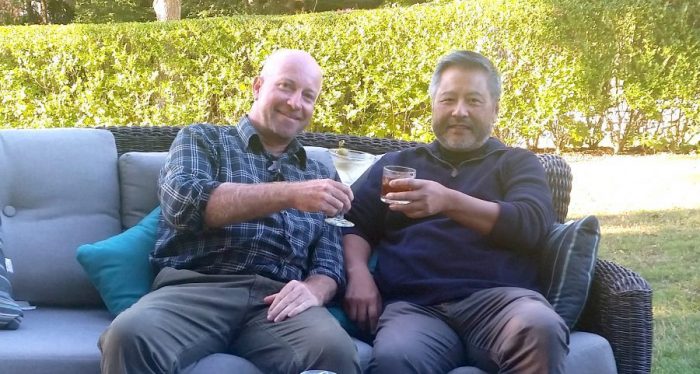By Daniel Dunaief
One person’s garbage is another’s treasure.

Benjamin Hsiao has plans to convert garbage — from dog poop to food waste and even cardboard boxes — into the kind of low cost materials and fertilizers that can help combat climate change. His primary target is agricultural residues because of their volume and collectability.
A Distinguished Professor of Chemistry at Stony Brook University, Hsiao and collaborator Darren Martin at the University of Queensland in Australia recently were awarded one of 16 multidisciplinary grants totaling $11.4 million from the National Science Foundation’s Convergence Accelerator program.
Hsiao, who is the primary investigator, will receive $570,000 over the next nine months in Phase I of the research effort while Martin will collect $180,000 from the Commonwealth Scientific and Industrial Research Organisation in Australia.
The researchers plan to take a zero waste approach to create a circular system that will generate efficiencies, reduce pollution and combat climate change.
The research is focused on creating immediate solutions for current problems, Hsiao said.
The NSF received “many quality submissions” and chose the winners after a rigorous review process, the NSF said.
The proposal from Hsiao and Martin stood out as it is “based on strong science” and make a clear connection to climate change,” NSF officials said.
Hsiao and Martin were delighted with the award and the opportunity not only to make contributions through their own research, but also to work with some of the other recipients.
“I am so pleased on many counts,” Martin explained in an email from Australia. First, Martin and Hsiao, who met at a conference in 2014, followed through on long standing plans to work together. Second, this program, which the NSF started in 2019, is about “early engagement with the market to get feedback on new technologies and platforms.”
Martin suggested it was akin to a “business model boot camp” that includes support and opportunities to pressure test ideas early. “This approach could really accelerate and compress the number of years traditionally taken to see helpful new technologies out in society sooner.”
If they are successful and effective, the scientists can apply for competitive Phase II funding within the year, which includes $5 million for two years and which four or five of the Phase I recipients, who are from a host of A-list research institutions, will receive.
Solids and liquids
Hsiao has been working with solid plant-based waste to create filters that can purify water at a low cost since 2009.
“Nanoscale cellulose materials can be used for water purification,” said Hsiao.
The needles of plants, from shrubs to bushes to feedstock, all have the same cellulosic nanostructure. Hsiao’s technology can convert these different feedstock into similar carboxy-cellulose nanofibers that can be used as purifying agents with negative charge. These filters can remove oppositely charged impurities.
Additionally, Hsiao plans to use solid plant based biomass to create a biogel. Rich in nutrients, the biogel is like the naturally occurring residue that is at the bottom of streams, which is a nutrient-rich mix of dead trees and grass.
The biogel, which is also funded by the NSF, has three applications. First, it can replace soil to grow food or for seed germination, which could be useful to grow food in space. It can also reduce the impact of drought.
Second, it can make a farm more resistant to drought because the material in biogel retains water for a longer period of time and amid drier conditions.
Third, the biogel can induce vegetation or plant growth in drier or sandier areas. Such growth, which could occur along the shoreline of Long Island, could help reduce erosion, Hsiao said. The biogel can also reduce desertification.
Martin explained that Stony Brook University and the University of Queensland have two different biogel platforms that they may hybridize.
Hsiao’s team is “very strong in the chemistry and physical chemistry side,” Martin wrote. “Being based in a Chemical Engineering School, we have been pretty good over the years at finding the most efficient, cost-effective ways to manufacture bio-based materials and composites at scale.”
Fertilizer
Building and expanding on this work, Hsiao is focusing on the liquid waste from biomass as well.
“With the new thinking, we have a circular design,” he said.
Using a nitric acid treatment that is similar to composting and that removes human pathogens, liquid biomass can become an effective fertilizer, which sanitizes animal and human waste.
Nitric acid also releases the existing nutrients in feedstock, which provides more nitrogen and phosphorous to help plants grow.
The ideal treatment would involve providing a controlled amount of fertilizer each day, Hsiao explained.
Farmers, however, can’t put that kind of time and resources into spraying their fields. Instead, they spray a fertilizer that becomes run off when it rains. Artificial intelligence and robots can deploy fertilizer in a more cost effective manner.
The nitrogen from the run off winds up in streams and other water bodies, where it can cause a process called eutrophication, leading to the kind of algal blooms that rob oxygen of water, making it more difficult for desirable marine life to survive and close beaches to swimming.
By using an efficient process for producing fertilizer that includes taking the inedible parts of plants, and making them a part of the circular process, run off could decrease by “half or even more,” Hsiao said.
Martin added that he and Hsiao have, in the back of their minds, a plan to create scalable fertilizer for single family farms in developed and developing nations.
“Our modeling may indeed show that ‘distributed manufacturing’ of the biogels from agricultural residues using a ‘mobile factory placed on the farm’ may be the smartest way to get there,” Martin explained. “This is exactly the sort of question the Convergence Accelerator is designed to test.”
Martin said that he hopes this technology lead to an array of jobs that support farming under a variety of circumstances.
Sorghum, which is one of his favorite crops, is ultra resilient and is of increasing global importance. Its ability to withstand environmental stress and thrive on low input marginal farmland make it the ‘golden crop of the future,’ Martin added.
This crop makes it an “attractive option to transform infertile land into profitable agrivoltaic farms supplying raw materials for emerging non-foo markets such as these biogels,” Martin wrote.












